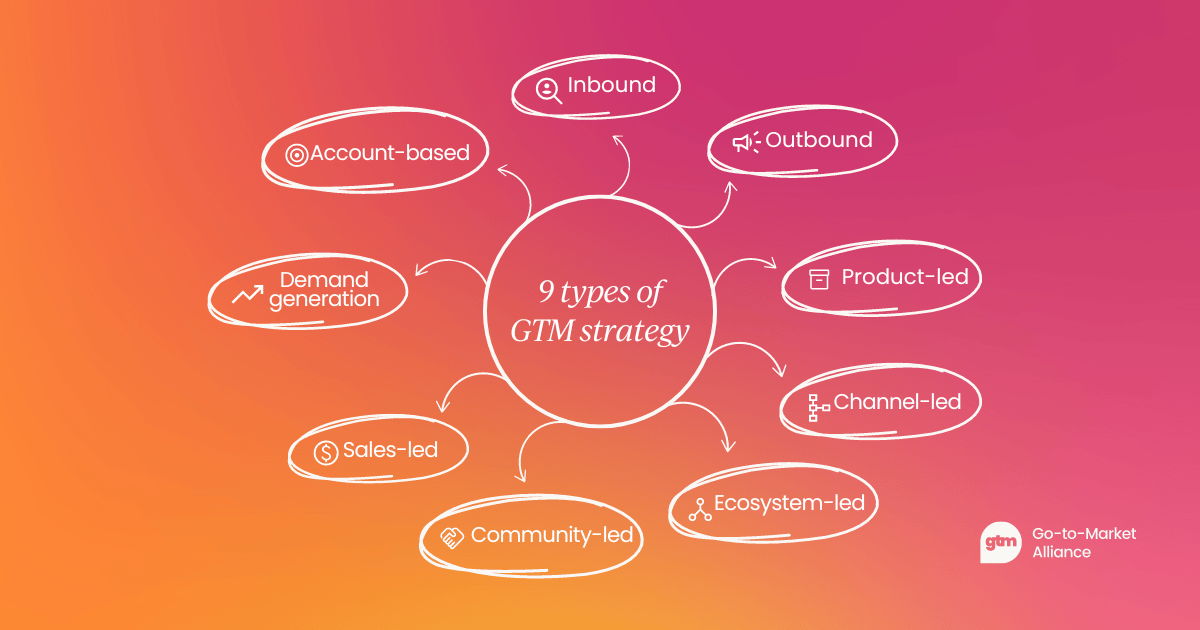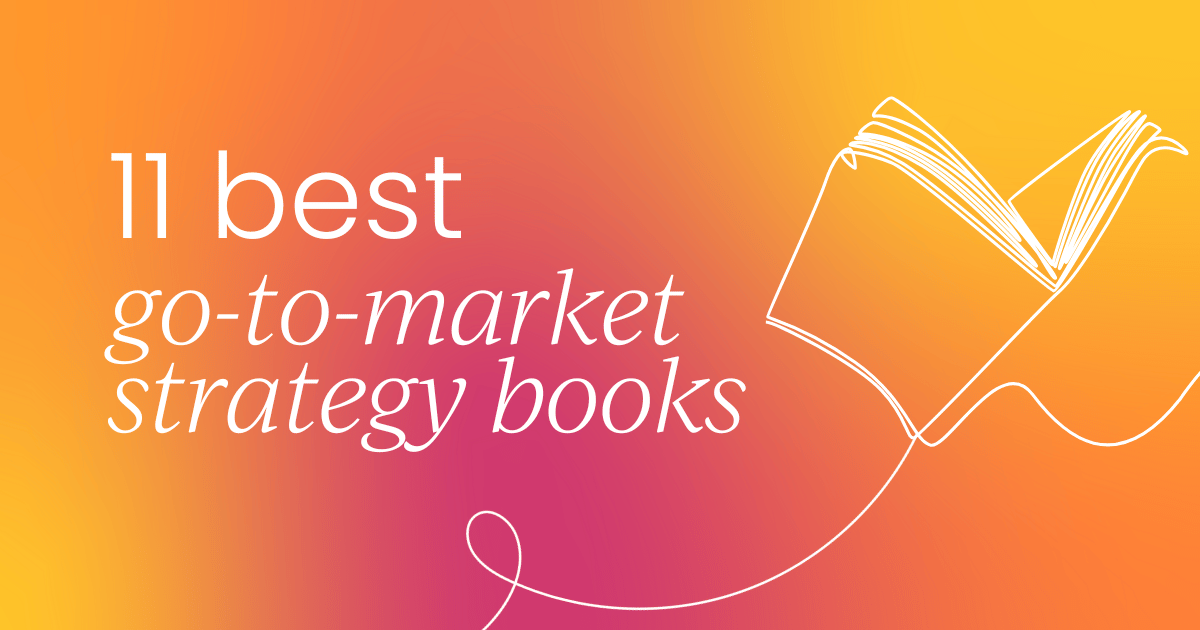There are so many different types of go-to-market strategies you could use for your business – it can be challenging to know which is best for your needs.
This article outlines nine different GTM strategies that you could use for your next launch as well as some guidance on which types of products and companies these strategies suit.

Looking for something in particular? Skip ahead:
- Inbound
- Outbound
- Product-led
- Channel-led
- Ecosystem-led
- Community-led
- Sales-led
- Demand generation
- Account-based
Inbound
Inbound strategies use content marketing to draw customers in, gain trust, and drive conversions. This GTM strategy works by providing your audience with valuable content and presenting your brand as a thought leader within your industry.
This strategy involves creating a range of content to educate and entertain your customers such as:
- Blog content and SEO
- Social media posts
- Reports and whitepapers
- Case studies
- Podcasts
- Videos
It's a versatile strategy just as at-home in an ecommerce Go-to-Market strategy as it would be in a SaaS business' GTM plan.
By providing this value to your customers, you generate organic brand awareness. In turn, this generates leads and conversions for your product or service as your audience trusts your brand.
Inbound GTM is a long-term investment that pays off over time. By providing customers with the right content at the right time, your pipeline almost fills itself!
This strategy is best for companies who want to become thought leaders in the industry, those with resources to invest in content creation, and whose products won’t change much over time.

Outbound
While inbound pulls customers in, outbound reaches out to your customers directly.
Rather than trying to get the word out to everyone, outbound GTM strategy focuses on making contact with prospects who fit into your ideal customer persona (ICP) and personalizing this outreach to their specific pain points.
This approach utilizes email outreach, cold calling, social selling, and paid lead lists to sell your product to your buyer persona. This more precise approach allows your team to personalize communication more effectively and improve close rates.
Product-led
Product-led strategy, also known as product-led growth (PLG) lets the product speak for itself. This approach relies on building trust and authority by providing the best product on the market.
This reduces pressure on sales and marketing teams as the product essentially markets itself. The product will also facilitate purchases, track behavior, conduct analysis, and receive feedback within its ecosystem. Most product-led companies also require fewer sales reps as they rely on a self-serve model.
PLG depends on having a great product with many potential uses and a talented team to update the product regularly. Your product team will likely run regular sprints to add new features and fix bugs to keep your customers satisfied.
“Product-led growth is about prioritizing the user experience in everything you do: your product, pricing, marketing, customer engagement, and even buying experience.
“An incredible user experience inevitably leads to faster growth, greater customer expansion, and best-in-class retention.”
– Kyle Poyar, Operating Partner at Openview.
This approach to GTM works best for:
- Early-stage start-ups in a new market or creating a new category.
- Products with a freemium pricing strategy.
- Companies who want to personalize the onboarding experience.
- Businesses that want to scale quickly with a low customer acquisition cost.
- Flexible payment options, such as membership upgrades, add-ons, etc.

Channel-led
A channel-led approach is where your business will focus on building a sales channel rather than a specific product or marketing technique.
This strategy builds a roadmap of how your products will get from manufacture to your customers. This relies on building relationships with other companies to promote and sell your products via various channels and intermediaries.
Examples of channels to consider are:
- Retailers
- Wholesalers
- Distributors
- Brokers
- Agents
- Online platforms
- Social media storefronts
- Affiliate marketing
A key consideration of using this approach is supporting your partners. This may involve providing them with training, resources, and incentives they’ll need to sell your products. For example, point-of-purchase (POP) displays or discounts for their customers.
The benefit of a channel-led strategy is tapping into markets beyond your reach by using your partners’ resources. This allows you to extend your presence without a large upfront cost.
With this in mind, channel-led works best for small companies selling physical products who want to keep their distribution costs low.

Ecosystem-led
Ecosystem-led GTM involves partnering with multiple companies to deliver an integrated offering to your customers. This approach involves connecting with complementary products so you can deliver an end-to-end experience for customers.
It's not just a one-off relationship with another business. The ecosystem approach builds a web of companies intertwined to deliver an all-inclusive service. This includes a network of suppliers, distributors, and providers.
This approach allows your company to offer more than you could offer in-house. This may mean partnering with companies outside of your traditional industry to find complementary products. For example, a suncream brand partnering with a swimwear brand.
Some benefits of an ecosystem approach include:
- Offering multiple layers of value.
- Wider reach through partners’ audiences.
- Stay ahead of competitors.
- Better data to drive decision-making.

Community-led
Community-led GTM strategy starts and ends with your customers. This approach relies on creating and building a community of supporters within your customer base. This engagement and loyalty leads to customer acquisition and revenue.
Being community-led requires maintaining a strong set of brand values and walking the walk when sharing your values with your customers. Ultimately these values must appear sincere and authentic to your audience.
Your customers also need a dedicated space to visit regularly and collaborate with other community members. Facilitating this meeting place allows your community to create value through interactions with each other.
Your organization can host this community on any platform that makes sense for your audience. Some examples include:
- Slack
- LinkedIn groups
- Facebook groups
- Instagram broadcast channels
- Discord
- Microsoft Teams
This approach to GTM takes time – but with patience and tweaks to your offering and messaging, your customer base will grow organically into a thriving community. Our founder says it best:
“Being community-led is a long-term strategy that focuses on building trust and delivering value to a specific group of people or demographic.
“The idea is to deliver true value that's also free, which can take the form of sharing great ideas, templates, frameworks, or any other content. Community members take value from each other by sharing their knowledge and resources.
“Over time, this builds trust and loyalty among members, and they become more receptive to potential offerings from a company.
“In essence, community-led growth is about building a relationship with a group of people and providing value to them in a way that engenders trust.”
– Richard King, Founder and CEO at The Alliance.
Sales-led
Often paired with outbound strategy, sales-led GTM focuses on generating sales via talented salespeople. This approach relies on your sales team to persuasively position your product to close deals. Your sales reps should be able to counter all objections your product could face.
This strategy helps to direct efforts at a narrow target audience that will find value in your offering. Conducting thorough research and properly defining your buyer personas will allow your sales reps to close deals effectively and forge strong relationships with your customers.
“The primary benefits come from the direct, personal connections you can forge with customers. You have the ability to understand customer needs at a detailed level and develop and customize your product to meet their needs and drive higher usage and adoption.
“You can also create the feedback loop your product teams need to develop new features and capabilities. This can create loyalty and advocacy that benefit the business and the brand for years to come.”
– Jarod Greene, Chief Marketing Officer at Vivun.
As your sales reps are the main focus of your GTM motion, it’s important to build a strong team and ensure they stay up-to-date on sales best practices. That’s why investing in sales enablement is crucial for sales-led organizations.
Sales-led strategy works best for companies:
- With lots of resources to invest in their salespeople and sales strategy.
- Looking to create one-on-one relationships with their customers.
- In a very competitive or oversaturated market.
- Offering complex or expensive products that need to be explained to prospects.
- With long sales cycles or custom pricing.

Demand generation
Demand generation utilizes inbound and outbound activities to generate warm, qualified leads who’ve already heard of your product and are interested in learning more. Some activities used in creating demand are content marketing, email campaigns, and paid lists.
This mixed approach to your GTM strategy will reduce the pressure on your sales and marketing teams by providing them the means to work together and create demand for your product.
You’d be right in thinking this sounds a lot like inbound, but the difference here is being sure of who your audience is and what their pain points are. Often inbound casts too wide of a net to bring in high-quality leads, demand generation solves this by narrowing in on an ICP.
With that in mind, demand generation works for companies that:
- Need to generate high-converting qualified leads.
- Are in a growth phase.
- Need to reduce the cost of converting leads into customers and retaining them.
- Want to create awareness and consideration for their products.
- Need to strengthen their customer relationships.

Account-based
An account-based go-to-market strategy uses one-to-one marketing aimed at a single company or buyer. These target accounts are large enterprise deals that your marketing and sales team will work to build a relationship with.
This involves identifying target accounts that fit your ICP, identifying key decision-makers, and creating personalized content for each account.
The account-based approach is resource intensive as each account you chase will have their own dedicated team, but this pays off when you secure large high-margin deals.
Account-based GTM works best for companies:
- Marketing to a small group of enterprise buyers.
- That don’t require a high sales volume to succeed.
- Looking to build close relationships with long-term clients.
- Selling high-margin products.

Which GTM strategy should you use?
As we’ve discussed, there are lots of different types of go-to-market strategies you could implement at your company. But that likely leaves you with a burning question: Which one should you use?
There’s no one-size-fits-all when it comes to GTM strategy (that’s why there are so many in the first place!). But there are some ways to decide which strategy is best for your business.
Your company’s goals, values, ideal customers, and product can all influence which strategy will work best.

Sometimes one strategy isn’t enough – you can also experiment with mixed or hybrid strategies to better suit your objectives.
While it may be difficult to use opposite approaches such as sales-led and product-led, you could utilize complementary approaches like inbound and community-led to strengthen your GTM strategy.
Using a combination of approaches in your GTM plan will allow you to cover more ground and tailor these strategies to the unique needs of your business and product.
Looking for more insight into GTM motions?
Discover comparisons of the most popular GTM motions, actionable advice for choosing the best motion to support your business, and expert advice from GTM leaders in our Go-to-Market Motions Playbook.
Get your copy now! 👇







